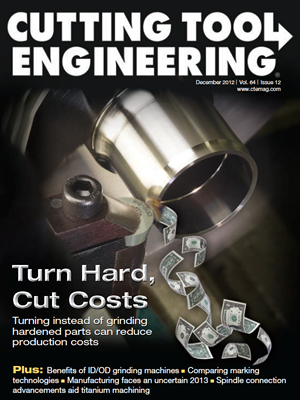In my August column, I described several common applications for workholding when turning, where the cutting tool is static and the workpiece spins. There are several standard workholders for turning, which were illustrated.
However, for clamped parts that are cut with a rotating tool, or parts held in position for specific processes, such as welding or broaching, many workholding applications are custom; you could probably create an encyclopedia with examples of workholders designed and built for specific parts. These unique workholding methods are often required to ensure part integrity is the same coming out as it was going in.
In addition, workholder intricacy varies. Workholding for milling machines can be as simple as clamps on a table or as complex as a hydraulically plumbed behemoth weighing thousands of pounds. Workholding for stamping presses comes from the die tool itself, which must support the tons of pressure applied to the material to achieve the desired form.
Other types of workholding for static parts require different approaches. For example:
- Broach fixtures require self-aligning features in order to correctly remove metal in a shearing motion.
- Workholders for weld cells require space to allow the welder to move between the weld points and weld at the correct angle.
- Assembly machines must hold parts accurately so other programmed motions are executed correctly.
The science behind any workholding technique is based on locating techniques outlined in my previous columns. The form may change, but the principles remain the same.
Workholding, of course, is still subject to limitations and encumbrances. Workholding designers must ask themselves, “Can we make it to the desired configuration on time and within budget?” More and more, part makers are being asked to both reduce manufacturing costs and justify their existing tooling budgets.
Workholder designers and builders are increasingly asked to answer these difficult questions. Can we:
- Get away with fewer clamps?
- Put more parts on the fixture and not exceed the machine tool’s load capacity?
- Avoid buying additional fixtures if we push cutting tools harder?
- Guarantee uptime with lower-cost fixtures and their components?
- Purchase workholding fixtures from an outside supplier and make that supplier responsible for workholder performance?
- Use fixtures to accommodate additional stresses not originally designed for?
- Buy pre-engineered locators and rest pads and still accurately locate the part while not worrying these components will quickly wear?
Manufacturing costs have been driven down by low-labor-cost countries so much that suppliers have been forced to manufacture products that may function correctly—but not necessarily well.
That puts more pressure on workholder designers and suppliers to develop novel solutions. Experience is often the best teacher. The art of designing and building functional and robust workholding is learned. That requires knowledge about materials, machine tools, heat-treat processes, welding, grinding, milling and other machining processes. All those elements must come together to create a fully functional workholder that will do what you ask of it.
One of my bosses, after 20 years of designing fixtures, said he saw himself as only a good beginner. I feel that same humility in my own machining experiences. Making lower-cost products that meet or exceed expectations is the challenge of our time, and we’ll have to use all our skills to meet that challenge.
Related Glossary Terms
- broach
broach
Tapered tool, with a series of teeth of increasing length, that is pushed or pulled into a workpiece, successively removing small amounts of metal to enlarge a hole, slot or other opening to final size.
- broaching
broaching
Operation in which a cutter progressively enlarges a slot or hole or shapes a workpiece exterior. Low teeth start the cut, intermediate teeth remove the majority of the material and high teeth finish the task. Broaching can be a one-step operation, as opposed to milling and slotting, which require repeated passes. Typically, however, broaching also involves multiple passes.
- fixture
fixture
Device, often made in-house, that holds a specific workpiece. See jig; modular fixturing.
- gang cutting ( milling)
gang cutting ( milling)
Machining with several cutters mounted on a single arbor, generally for simultaneous cutting.
- grinding
grinding
Machining operation in which material is removed from the workpiece by a powered abrasive wheel, stone, belt, paste, sheet, compound, slurry, etc. Takes various forms: surface grinding (creates flat and/or squared surfaces); cylindrical grinding (for external cylindrical and tapered shapes, fillets, undercuts, etc.); centerless grinding; chamfering; thread and form grinding; tool and cutter grinding; offhand grinding; lapping and polishing (grinding with extremely fine grits to create ultrasmooth surfaces); honing; and disc grinding.
- milling
milling
Machining operation in which metal or other material is removed by applying power to a rotating cutter. In vertical milling, the cutting tool is mounted vertically on the spindle. In horizontal milling, the cutting tool is mounted horizontally, either directly on the spindle or on an arbor. Horizontal milling is further broken down into conventional milling, where the cutter rotates opposite the direction of feed, or “up” into the workpiece; and climb milling, where the cutter rotates in the direction of feed, or “down” into the workpiece. Milling operations include plane or surface milling, endmilling, facemilling, angle milling, form milling and profiling.
- sawing machine ( saw)
sawing machine ( saw)
Machine designed to use a serrated-tooth blade to cut metal or other material. Comes in a wide variety of styles but takes one of four basic forms: hacksaw (a simple, rugged machine that uses a reciprocating motion to part metal or other material); cold or circular saw (powers a circular blade that cuts structural materials); bandsaw (runs an endless band; the two basic types are cutoff and contour band machines, which cut intricate contours and shapes); and abrasive cutoff saw (similar in appearance to the cold saw, but uses an abrasive disc that rotates at high speeds rather than a blade with serrated teeth).
- turning
turning
Workpiece is held in a chuck, mounted on a face plate or secured between centers and rotated while a cutting tool, normally a single-point tool, is fed into it along its periphery or across its end or face. Takes the form of straight turning (cutting along the periphery of the workpiece); taper turning (creating a taper); step turning (turning different-size diameters on the same work); chamfering (beveling an edge or shoulder); facing (cutting on an end); turning threads (usually external but can be internal); roughing (high-volume metal removal); and finishing (final light cuts). Performed on lathes, turning centers, chucking machines, automatic screw machines and similar machines.


